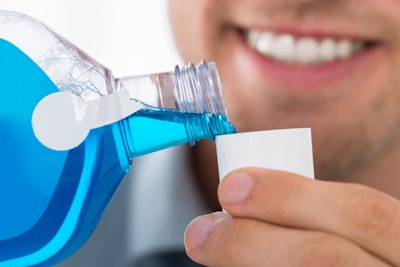
Although preferred for taste, an alcohol-free, essential oils-containing mouthwash may be less effective at controlling plaque than alcohol-based versions, according to a systematic review published in the International Journal of Dental Hygiene.
However, an essential oils mouthwash without alcohol (EOalc−) and an essential oils mouthwash with alcohol (EOalc+) show similar results for reducing gingival bleeding and gingivitis, the authors wrote.
"When an EO-mouthwash is used in non-brushing or brushing situations, with small to moderate certainty, EOalc- provided less effect regarding plaque control than EOalc+," wrote the authors, led by B.W.M. van Swaaij of the University of Amsterdam and Vrije Universiteit in the Netherlands (Int J Dent Hyg, August 12, 2024).
A search strategy was developed to compare EOalc− and EOalc+ in terms of plaque, bleeding, gingivitis, taste perception, taste alteration, and residual taste after rinsing. Two reviewers conducted the search using Medline-PubMed and the Cochrane Central Register of Controlled Trials databases, covering studies published up to March 2024, they wrote.
The inclusion criteria required randomized controlled trials or controlled clinical trials involving adults without systemic disorders, fixed orthodontic equipment, dental implants, or removable dental prostheses. A systematic electronic search identified seven eligible papers. A meta-analysis was then performed to evaluate the effectiveness of EOalc− versus EOalc+, they wrote.
The descriptive analysis revealed a significant improvement in plaque scores for EOalc+. This was further confirmed by meta-analyses in both nonbrushing (difference of means [DiffM] = 0.40; 95% confidence interval [CI], 0.27-0.53; p < 0.00001) and brushing studies (DiffM = 0.05; 95% CI, 0.01-0.10; p = 0.01).
However, meta-analyses of bleeding and gingival scores in brushing studies showed no significant differences between the products. In terms of user preference, EOalc− was favored for taste perception (DiffM = 1.63; 95% CI, 0.72-2.55; p = 0.0004), according to the authors.
However, the study had limitations, including that most of the included studies had small sample sizes. Larger studies may be needed to better detect potential differences, the authors wrote.
"An EOalc− can be considered a valid recommendation due to its perceived better taste, which may improve patient compliance," they wrote.




















